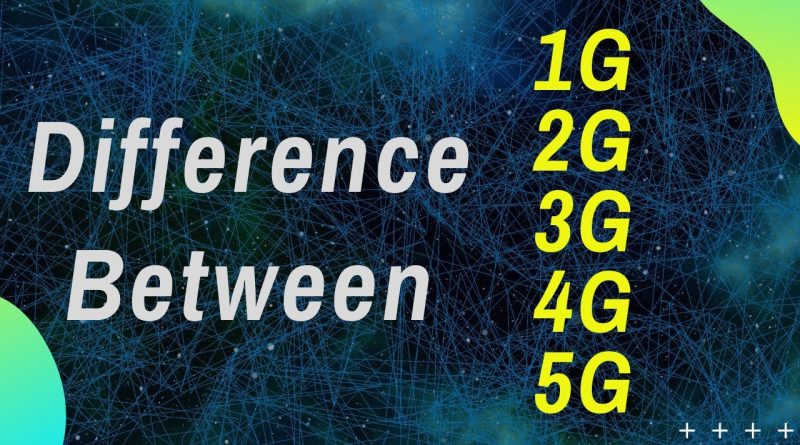Difference Between 1G, 2G, 3G, 4G and 5G Technology in Hindi | #19
1G, 2G, 3G, 4G, and 5G are different generations of mobile communications technology, each representing a significant advancement over the previous generation. The main differences between these generations are the types of wireless networks they use, the data rates they support, and the services and features they offer.
Blog: https://medium.com/@ahirlog/difference-between-1g-2g-3g-4g-and-5g-technology-52fa9312d9e9
1G (first generation) refers to the first generation of wireless mobile communication systems, which were based on analog technology and operated in the frequency range of 800-900 MHz. 1G systems supported voice calls and simple text messaging, but did not support data services such as internet access.
2G (second generation) refers to the second generation of wireless mobile communication systems, which were based on digital technology and operated in the frequency range of 900-1800 MHz. 2G systems supported voice calls, text messaging, and limited data services such as internet access and email.
3G (third generation) refers to the third generation of wireless mobile communication systems, which were based on digital technology and operated in the frequency range of 1900-2100 MHz. 3G systems supported high-speed data services such as internet access, video calls, and streaming media, as well as voice calls and text messaging.
4G (fourth generation) refers to the fourth generation of wireless mobile communication systems, which are based on digital technology and operate in the frequency range of 700-2600 MHz. 4G systems support even higher data rates and a wide range of data-intensive services, including high-definition video streaming and online gaming.
5G (fifth generation) refers to the fifth generation of wireless mobile communication systems, which are based on digital technology and operate in a wide range of frequency bands. 5G systems support even higher data rates and a wide range of advanced services, such as ultra-high-definition video, virtual reality, and the Internet of Things (IoT).
Each generation of mobile communication technology has brought significant improvements in terms of data rates, coverage, and the types of services and features offered. 5G is expected to be the most advanced generation of mobile communication technology to date, offering even faster data rates, lower latencies, and a wider range of advanced services.
Blog: https://www.ahirlog.com/2022/11/difference-between-1g-2g-3g-4g-and-5g.html
My YouTube Gear:
Boya BYM1(Mic): https://amzn.to/3bvm69j
Redmi Note 7 Pro(Mic & Camera): https://amzn.to/3uRkVsb
MSI Motherboard: https://amzn.to/3fiQHYO
Intel i3 Processor: https://amzn.to/3w8TWbQ
Mouse: https://amzn.to/3yb8PMP
Keyboard: https://amzn.to/3bvmtkd
Wifi Adaptor: https://amzn.to/3fiQYuO
SSD: https://amzn.to/3w2w2Pa
Speakers: https://amzn.to/3w6pKhv
————————–
Optical Fiber Cable | Fiber Optic Cable | Guided Medium in Hindi | #11
Difference Between Twisted Pair Cable, Coaxial Cable and Fibre Optics Cable in Hindi | #10
Difference Between Asymmetric Key Cryptography and Symmetric Key Cryptography in Hindi | #16
What is IPv4 ? | IPv4 Classes A, Classes B, Classes C, Classes D and Classes E in Hindi | #15
What is IPv6? | IP Address Version 6 in Hindi | #17
Difference Between TCP and UDP in Hindi | #22
Difference Between GSM and CDMA in Hindi | #21
Difference Between AM Broadcasting and FM Broadcasting in Hindi | #20
Difference Between 1G, 2G, 3G, 4G and 5G Technology in Hindi | #19
Difference Between IPv4 and IPv6 in Hindi | #18
Difference Between Pure ALOHA and Slotted ALOHA in Hindi | #23
Differences Between Bit Rate and Baud Rate in Hindi | #26
————————–
Instagram: https://www.instagram.com/ahirlog/
Facebook: https://www.facebook.com/ahirlog
Twitter: https://twitter.com/ahirlog
YouTube: https://www.youtube.com/ahirlog
5g vs 4g




Dhanyavad 🙏🙏🙏🙏🙏🙏🙏🙏🙏🙏🙏🙏🙏🙏🙏🙏🙏🙏🙏🙏🙏🙏🙏🙏🙏🙏🙏🙏🙏🙏🙏🙏🙏🙏🙏🙏🙏🙏🙏🙏🙏🙏🙏🙏🙏🙏🙏🙏🙏🙏🙏🙏🙏🙏🙏🙏🙏🙏🙏🙏🙏🙏🙏🙏🙏🙏🙏🙏🙏🙏🙏🙏🙏🙏🙏🙏🙏🙏🙏🙏🙏🙏🙏🙏🙏🙏🙏
Eho is learing before exam😢😢
useless video
What is wcdma ? Explain in video.
Please make video of mms.
Your video is understandable to me. Please make more videos.
Thanks